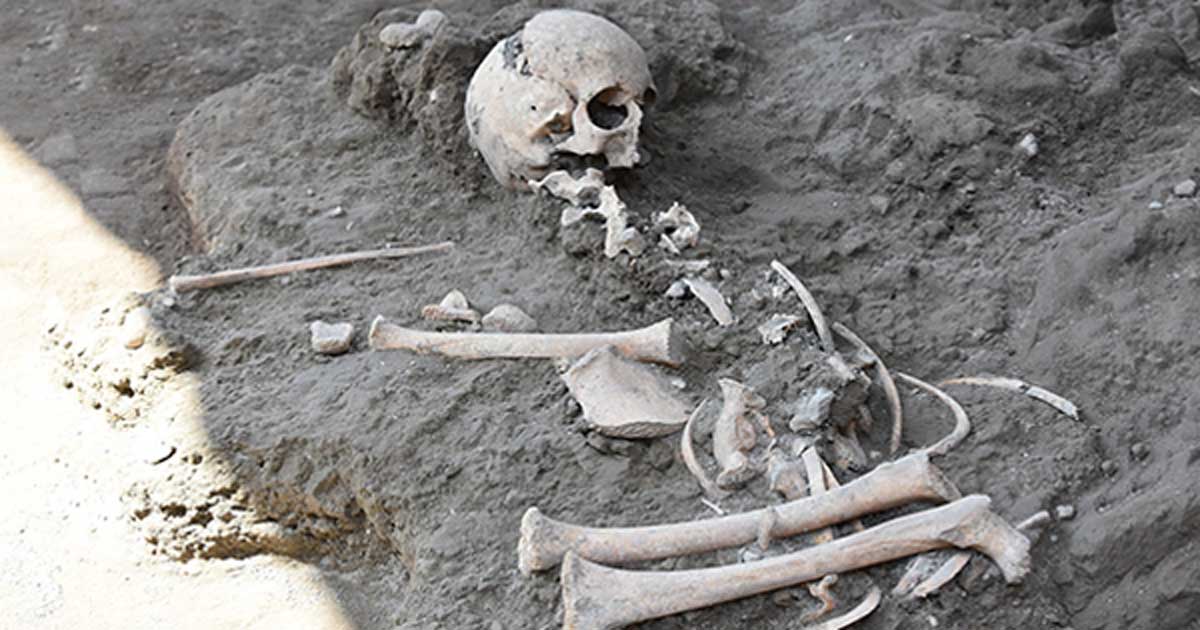Skeleton Found in Pompeii Belonged to Child Seeking Shelter from Deadly Volcanic Eruption
Among the ruins of the ancient city of Pompeii, archaeological excavations have revealed the skeleton of a child who died in a volcanic eruption. Mount Vesuvius erupted in 79 AD and destroyed the city of Pompeii, a busy port, along with neighbouring Herculaneum. For many centuries the city lay under the earth, forgotten, near the bustling city of Naples. However, since the eighteenth century it has been extensively excavated and is now a massive archaeological site. Skeletons have been preserved in the ash and debris of Pompeii, and many have been recovered by archaeologists over the years. Pompeii's director Massimo Osanna announced the discovery of the child’s skeleton on the 25th of April.
- Archaeologists Find Pompeii Victims Who Perished in a Shop
- The Houses of Pleasure in Ancient Pompeii

The child skeleton was found in crouching position in the bath complex of the town. Image: Parco Archeologico de Pompeii
A Child in Hiding
The child is estimated to have been seven or eight years old and was discovered in a crouching position. The skeleton was found in the public thermal bath complex, which was one of the most important public buildings in Pompeii. It is speculated that the child died here while seeking shelter from the volcanic ash, gas, and pumice. The skeleton is relatively intact, and this would suggest that the child was killed by the flow of hot ash and gas that descended upon Pompeii. Those who did not flee the volcanic ash cloud would have perished.
It is estimated that some 10% of Pompeii’s population died, approximately 2000 men, women and children. The majority of them, like the child whose skeleton has been discovered, died either as a result of the pyroclastic flows or they were suffocated by poisonous ash. A pyroclastic flow is a current of hot gas and volcanic matter that is emitted by an erupting volcano and that moves at a great speed. They are often impossible to escape by foot.
- New Scans of Ancient Pompeii Victims Reveal Great Teeth and Good Health
- Extremely rare discovery of Pre-Roman tomb in Pompeii will shed light on its early history

The remans of the child were found in one of the baths of the bath complex. Image: Parco Archeologico de Pompeii
Analysis of the Scene
It appears that the pyroclastic flow that swept down from Vesuvius and descended upon Pompeii after the eruption is what has preserved the remains of the child. It is theorized that the flow of hot gas and ash flooded through the windows and doors into the bath complex. The ash and gas flow buried the child, and this solidified over the body when rain fell, encasing the young victim. The skeleton had been sealed in the bath by the pyroclastic flow, according to the American publication Archaeology. This allowed the skeleton to remain undisturbed for millennia.
- A Diet of Delicacies for the People of Pompeii Included Giraffe and Sea Urchin
- Frozen in Time: Casts of Pompeii Reveal Last Moments of Volcano Victims
Maintenance Work Prompted the Find
The find was made during a sweep of the bath complex by a team of archaeologists using the latest scanning equipment, a videoscope. The archaeologists surveyed the area with the equipment as efforts were being made to prevent the ruined walls of the thermal bath from falling. The new technology enabled the archaeological team to investigate areas of the sprawling site that had not been investigated in many decades. With the aid of the videoscope they were able to detect something unusual beneath the surface and this persuaded them to dig in the baths. The thermal baths of the ruined city had, it was believed, already been excavated and the discovery of the skeleton was a surprise to the archaeologists. According to Phys.org, there is speculation that the skeleton had been previously found in the nineteenth century. This was based on the fact that the leg bones appeared to have been placed next to the body, presumably by a person. However, for some reason they had not been removed or even recorded.

Pompeii Director, Massimo Osanna and a colleague inspect the find. Image: Parco Archeologico de Pompeii
A Rare Find for Pompeii
The skeleton was unearthed in February, but the discovery was not publicized at the time, which is standard practice with such finds. It is the first complete skeleton uncovered in two decades and the first child’s skeleton to be uncovered in fifty years. The remains of the child have been removed to a laboratory in Naples for further investigation. The skeleton will undergo a series of extensive tests by an interdisciplinary team of experts. It is hoped that the tests will allow the sex of the child to be established by analysis of its DNA. There will also be tests that seek to determine the age of the child and its general health. The fact that this is the first child to be discovered in fifty years means that experts can now learn more about the lives of the children of Pompeii. The team examining the remains are using the latest technology to discover as much as possible about the skeleton and also what it can tell about life in Pompeii before its fiery destruction.
Top image: The child skeleton recently discovered at Pompeii. Source: Parco Archeologico de Pompeii
By Ed Whelan

















